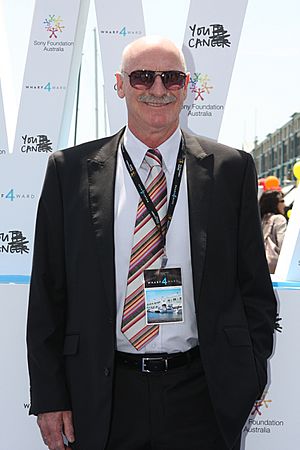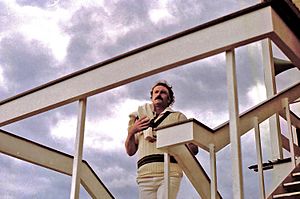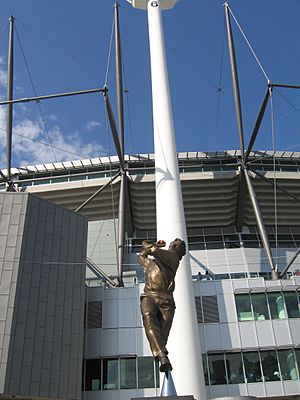Dennis Lillee facts for kids

Lillee at the Sony Foundation's Youth Cancer campaign
|
||||||||||||||||||||||||||||||||||||||||||||||||||||||||||||||||||
| Personal information | ||||||||||||||||||||||||||||||||||||||||||||||||||||||||||||||||||
|---|---|---|---|---|---|---|---|---|---|---|---|---|---|---|---|---|---|---|---|---|---|---|---|---|---|---|---|---|---|---|---|---|---|---|---|---|---|---|---|---|---|---|---|---|---|---|---|---|---|---|---|---|---|---|---|---|---|---|---|---|---|---|---|---|---|---|
| Full name |
Dennis Keith Lillee
|
|||||||||||||||||||||||||||||||||||||||||||||||||||||||||||||||||
| Born | 18 July 1949 Subiaco, Western Australia |
|||||||||||||||||||||||||||||||||||||||||||||||||||||||||||||||||
| Nickname | FOT | |||||||||||||||||||||||||||||||||||||||||||||||||||||||||||||||||
| Height | 1.82 m (6 ft 0 in) | |||||||||||||||||||||||||||||||||||||||||||||||||||||||||||||||||
| Batting | Right-handed | |||||||||||||||||||||||||||||||||||||||||||||||||||||||||||||||||
| Bowling | Right-arm fast | |||||||||||||||||||||||||||||||||||||||||||||||||||||||||||||||||
| Role | Bowler | |||||||||||||||||||||||||||||||||||||||||||||||||||||||||||||||||
| International information | ||||||||||||||||||||||||||||||||||||||||||||||||||||||||||||||||||
| National side | ||||||||||||||||||||||||||||||||||||||||||||||||||||||||||||||||||
| Test debut (cap 254) | 29 January 1971 v England | |||||||||||||||||||||||||||||||||||||||||||||||||||||||||||||||||
| Last Test | 2 January 1984 v Pakistan | |||||||||||||||||||||||||||||||||||||||||||||||||||||||||||||||||
| ODI debut (cap 13) | 24 August 1972 v England | |||||||||||||||||||||||||||||||||||||||||||||||||||||||||||||||||
| Last ODI | 18 June 1983 v West Indies | |||||||||||||||||||||||||||||||||||||||||||||||||||||||||||||||||
| Domestic team information | ||||||||||||||||||||||||||||||||||||||||||||||||||||||||||||||||||
| Years | Team | |||||||||||||||||||||||||||||||||||||||||||||||||||||||||||||||||
| 1969/70–1983/84 | Western Australia | |||||||||||||||||||||||||||||||||||||||||||||||||||||||||||||||||
| 1987/88 | Tasmania | |||||||||||||||||||||||||||||||||||||||||||||||||||||||||||||||||
| 1988 | Northamptonshire | |||||||||||||||||||||||||||||||||||||||||||||||||||||||||||||||||
| Career statistics | ||||||||||||||||||||||||||||||||||||||||||||||||||||||||||||||||||
|
||||||||||||||||||||||||||||||||||||||||||||||||||||||||||||||||||
|
Medal record
|
||||||||||||||||||||||||||||||||||||||||||||||||||||||||||||||||||
|
Source: CricketArchive, 14 January 2009
|
||||||||||||||||||||||||||||||||||||||||||||||||||||||||||||||||||
Dennis Keith Lillee (born 18 July 1949) is a famous retired Australian cricketer. Many people consider him the best fast bowler of his time. He was known for his amazing partnership with fellow bowler Jeff Thomson. Together, they formed one of the greatest bowling duos in cricket history.
Early in his career, Dennis Lillee was incredibly fast. However, he suffered several back injuries called stress fractures. These injuries almost ended his career. But Dennis worked hard on a strict fitness plan and made a strong comeback to international cricket. When he retired in 1984, he held the world record for the most wickets in Test cricket. He had taken 355 wickets. Dennis Lillee became one of Australia's most famous and respected sports stars. He was also part of the Australian team that came second in the 1975 Cricket World Cup.
In 2009, Dennis Lillee was added to the ICC Cricket Hall of Fame. This honor recognizes the greatest cricket players.
Contents
Cricket Career Highlights
Dennis Lillee started his first-class cricket career at age 20. He played for Western Australia in 1969–70. He quickly impressed everyone with his raw speed. In his first season, he took 32 wickets, becoming Western Australia's top wicket-taker.
Starting in Test Cricket
The next season, Lillee made his Test debut in 1971 during the Ashes series against England. He took 5 wickets for 84 runs in his first match. His first Test wicket was John Edrich. Later, in another match, John Hampshire became the first batsman to be "caught Marsh, bowled Lillee." This phrase became very famous.
In 1971–72, Lillee showed his amazing talent against a strong team called the Rest of the World XI. He took 8 wickets for only 29 runs in one innings. This was his best bowling performance ever in an innings. Even famous player Garry Sobers said Lillee's bowling that day was the fastest he had ever faced.
Lillee continued his success on the Ashes tour of England in 1972. He took 31 wickets and was the best bowler in the series. Because of his great performance, he was named one of Wisden's five Cricketers of the Year for 1973.
Overcoming Back Injury
During a match in 1972–73, Lillee felt sharp pain in his back. He was later diagnosed with stress fractures in his lower back. This injury forced him to stop playing cricket for a while. He even had to wear a plaster cast around his body. Many people thought his bowling career was over.
But Dennis Lillee did not give up. He followed a tough physiotherapy program and changed his bowling style. In 1974–75, he returned to Test cricket for the Ashes series. He teamed up with Jeff Thomson, another fast bowler. They became one of the most effective bowling pairs in Test cricket. Their partnership helped Australia win the series easily. In 1975, experts measured Lillee's bowling speed at 154.8 kilometers per hour.
The Famous Lillee and Thomson Duo
The Lillee/Thomson bowling attack was so powerful that a Sydney newspaper wrote a famous line about them:
Ashes to Ashes, dust to dust, if Thomson don't get ya, Lillee must.
Lillee played in the first ever 1975 Cricket World Cup in 1975. He took 8 wickets in five matches, including 5 wickets for 34 runs against Pakistan. This was the first time a bowler took five wickets in a One Day International (ODI) match. In the Test series against England that followed, Lillee took 21 wickets. He also scored 73 runs not out in one match, helping Australia out of a tough spot.
In 1975–76, he took another 27 wickets against the West Indies. At this time, Dennis Lillee was very popular in Australia. However, he was not happy with how little money players earned from cricket. He suggested that a special TV series could be played to earn more money for the players. His manager, John Cornell, took this idea to Kerry Packer, which led to the creation of World Series Cricket (WSC).
World Series Cricket Era

Dennis Lillee joined World Series Cricket (WSC) in 1977. WSC was a new professional cricket competition. Lillee's image and personality were very important in promoting WSC games. He worked on his bowling action and fitness. In 1978–79, he took 46 wickets in nine "Supertests" (special WSC matches). His best was 7 wickets for 23 runs against the West Indies XI.
When he returned to official cricket, Lillee bowled a bit slower and with a shorter run-up. He focused on making the ball move off the seam. He took 35 Test wickets in six matches against the West Indies and England. In the World Series Cup, he took 20 wickets in eight ODIs.
Australian and World Records

In 1980–81, Lillee took 37 wickets in six Tests against New Zealand and India. He was also the top bowler in the World Series Cup for the second year in a row. He helped Australia win the competition for the first time by taking 25 wickets.
Lillee broke Richie Benaud's Australian Test record of 248 wickets. In 1981, he toured England again and took 39 Test wickets, which was his best performance in a series. He won "man of the match" awards in two Tests. He formed a strong partnership with Terry Alderman, who took a record 41 wickets. Even though Australia had this powerful bowling attack, they lost the series. However, Lillee's efforts made him the number one Test bowler in the world in 1981.
In 1981–82, Lillee was involved in a famous incident with Javed Miandad during a Test match. He continued to take many wickets: 15 in three Tests against Pakistan and 16 in three Tests against the West Indies. In a match against the West Indies, his 7 wickets for 83 runs helped him pass Lance Gibbs' world record for the most Test wickets.
Retirement from Cricket
Lillee suffered a serious knee injury in 1982, which made him miss part of the Ashes series. When he returned, he was no longer the first choice to bowl with the new ball. His ability to take wickets was slowly decreasing.
In 1983, his ODI career ended during the 1983 Cricket World Cup in England. He admitted he was not fully fit. During the 1983–84 season, he took only one wicket in the first two Tests against Pakistan. However, another player's injury allowed him to play the rest of the series. He finished with 20 wickets. Dennis Lillee announced his retirement during the final Test match in Sydney, along with Greg Chappell. He took 8 wickets in that match, including a wicket with his very last ball.
Caught Marsh Bowled Lillee

Throughout his career, Dennis Lillee was famous for his partnership with wicket-keeper Rod Marsh. The phrase 'c Marsh b Lillee' appeared 95 times in Test matches. This is a record for a wicket-keeper and bowler partnership that still stands today. Both players ended their careers with 355 Test dismissals. In 1988, a new grandstand at the WACA Ground was named the Lillee-Marsh Stand to honor them.
After Retirement from Playing
After retiring from international cricket, Lillee briefly played first-class cricket for Tasmania in 1987–88. He also played for an English county team, Northamptonshire, in 1988.
Since then, Dennis Lillee has focused on helping and coaching young bowlers. Some famous bowlers he has mentored include Brett Lee, Shaun Tait, Mitchell Johnson, and Pat Cummins. He was also involved with the MRF Pace Foundation in India, which trains fast bowlers.
From 2004 until 2015, Lillee was the president of the Western Australian Cricket Association.
Dennis Lillee's Legacy
Dennis Lillee has received many honors for his contributions to cricket:
- He was one of the Wisden Cricketers of the Year in 1973.
- He was appointed a Member of the Order of the British Empire (MBE) in 1981 for his services to cricket.
- In 1996, he was one of the first ten people inducted into the Australian Cricket Hall of Fame.
- He was chosen for the official Australian Cricket Board Team of the Century.
- He received the Australian Sports Medal in 2000.
- He was appointed a Member of the Order of Australia (AM) in 2010.
- Lillee was inducted into the Sport Australia Hall of Fame in 1985.
- He was mentioned in the Men at Work song "No Restrictions" (from the album Cargo, 1983).
- He was also mentioned in the Iain Campbell Smith song "Blue Guitar".
- He was named as a bowler in Australia's "greatest ever ODI team."
- In 2021, he was named an Australia Post Legend of Cricket.
- He was recognized as the 43rd Legend in the Sport Australia Hall of Fame in 2021.

